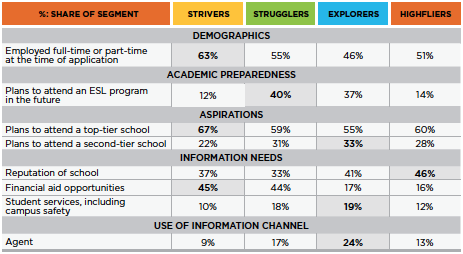You have /5 articles left.
Sign up for a free account or log in.
Colleges that use agents to recruit international students should expect to attract applicants with weaker academic profiles. According to a research report released today by World Education Services, a credential evaluation organization, 62 percent of agent-users have low levels of academic preparedness and will require additional academic support -- such as intensive English coursework -- once on a U.S. campus.
The report, based on a survey of 1,578 prospective international students from 115 countries, groups students based on financial resources and academic preparedness -- including English language proficiency -- and identifies which recruitment strategies are most effective in reaching each of four groups:
- “Strivers”: high levels of academic preparedness, low financial resources (30 percent of all respondents)
- “Strugglers”: low levels of academic preparedness, low financial resources (21 percent of all respondents)
- "Explorers”: low levels of academic preparedness, high financial resources (25 percent of all respondents)
- “Highfliers”: high levels of academic preparedness, high financial resources (24 percent of respondents)
The researchers identified the proportions of prospective students from each category who use various information channels, including institutional websites, education fairs, social media sites, and agents. They found that agent-users are disproportionately of the “explorer” or “struggler” categories. (“Explorers” and “strugglers” make up 40 and 22 percent of agent-users, respectively, even though together they compose just 46 percent of all respondents.) Furthermore, “strugglers” who engage agents are most likely to rely on hands-on assistance during the application process: 72 percent contracted their agents to edit their application materials, while 63 percent prepared for admissions interviews with their agents’ assistance.
As the report states, “[Higher education institutions] considering the use of agents for international recruitment purposes should be aware that the typical agent-using student needs plenty of guidance and support not only during the application process, but also during their first semesters in the United States. Therefore, institutions must realistically assess their capacity to provide ample academic support -- such as ESL and foundation courses -- to international students with low levels of academic preparedness before they engage the services of third-party recruiters.”
The use of agents in international recruiting remains controversial, mainly due to the practice of paying agents per-student commissions: federal law bars incentive-based compensation in domestic student recruitment, and many argue that the same standard should hold when colleges venture overseas. However, Rahul Choudaha, WES’s director of research and advisory services, said that his goal is to bring new data to the discussion, not to offer value judgments. “We’re not saying whether this is a right practice or a wrong practice,” Choudaha said. “But is it the right fit? Is your institution going to go the extra mile in providing those extra services? Otherwise, it’s going to backfire in the short- to medium-term.”
Choudaha emphasized that the take-away of the report is that institutions should match their recruitment strategies to the types of students they want to recruit – and can responsibly support. “If you want highfliers, they’re not going to agents. You want strivers, they’re not going to agents,” he said. “My analogy is if you want Macy’s quality, you go to a Macy’s store; you don’t try to find that quality in the dollar store.”
Rather than view all international students as alike, Choudaha stressed that different segments of students “need different information, and we have different ways to find them,” as seen in the tables below.
Differences in Profile and Information-Seeking Habits of International Students

Ron Cushing, director of international services at the University of Cincinnati, said that it’s not surprising that students who use agents would have lower English proficiency, given that the agent market is particularly hot in non-English speaking countries such as China, South Korea and Vietnam. But he suggested that colleges do have control over the quality of applicants referred by agents. “This is where the institution’s selection of agents and their training of agents becomes very critical,” said Cushing, who chairs the research committee of the American International Recruitment Council, which certifies agents. “If a prospective student walks into one of our agents’ offices today, and presents their educational credentials, the agent should be able, on the spot, to say whether he has any chance of getting into the University of Cincinnati.”
Where Different Types of Students Sought Their Information

Norm Peterson, executive director of international programs at Montana State University and a member of AIRC’s board, said that in admissions decisions, “the buck stops at the institution.”
“We work very hard with our agents around the world to make sure that they understand what our standards are and what our admissions criteria are, because it doesn’t do them any good and it doesn’t do us any good to receive applications from students who are not ready to succeed at Montana State University,” Peterson said.
Another main message of the WES report is that agents are only part of the recruitment picture: one-sixth of respondents indicated they had used agents, suggesting, the authors write, that agent use may be much less widespread than previous research has suggested. (That assertion comes with a significant caveat. In the limitations section, the authors note that 36 percent of respondents dropped out of the survey when they got to the questions about agents.)
In any case, the report identifies social media as a strategy that reaches students across segments – but the findings suggest that many colleges aren’t yet realizing its full potential. Students surveyed complained that some social media accounts “do little more than redirect applicants to the institution’s main website.” By contrast, those applicants who reported a positive experience with social media “frequently mentioned the opportunity to connect and converse with staff, faculty, and other students.”
The WES report also includes comparative profiles of prospective students from the top two sending countries, China and India. Students from these two countries made up 33 percent of the survey population.



